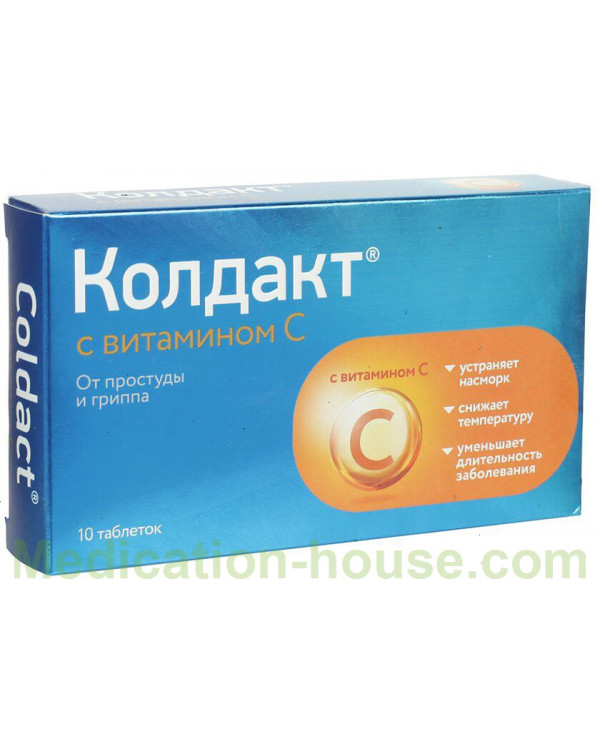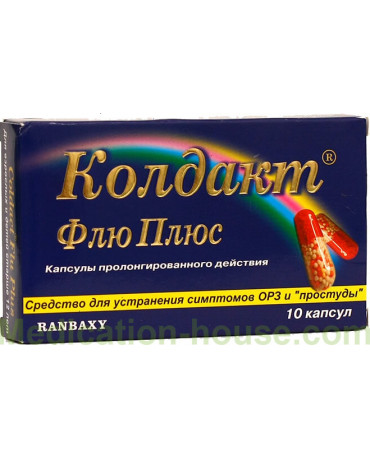Coldact with vitamin C instruction
You can buy Coldact with vitamin C here
Composition Coldact with vitamin C
Each film-coated tablet contains
Active substances:
paracetamol 650.00 mg
phenylephrine hydrochloride 10.00 mg,
chlorphenamine maleate 4.00 mg,
Ascorbic acid, coated 31.35 mg, in terms of Ascorbic acid 30.00 mg (contains 1.35 mg of stearyl alcohol).
Excipients: colloidal silicon dioxide 15.00 mg, pregelatinized starch 50.00 mg, microcrystalline cellulose 95.65 mg, sodium carboxymethyl starch 30.00 mg, povidone K30 30.00 mg, talc 5.00 mg, magnesium stearate 9.00 mg Film coat: Opadry brown OY56524 27.90 mg.
Composition Opadra brown OY56524: hypromellose 63.650%, titanium dioxide (E171) 20.140%, iron dye oxide (red) (E172) 8.860%, macrogol 6000 6.300%, iron dye oxide (yellow) (E172) 1.050%.
Pharmacodynamics
Paracetamol. It has an analgesic and antipyretic effect, similar to the action of salicylates. Paracetamol also exhibits weak anti-inflammatory activity. In equal doses, the degree of analgesic and antipyretic effect is comparable to the action of aspirin.
Paracetamol lowers body temperature in patients with fever, but rarely reduces normal temperature. Antipyretic effect through the hypothalamus. Heat reduction is achieved due to vasodilation and increased peripheral blood flow.
Phenylephrine hydrochloride. It is a vasoconstrictor from the group of sympathomimetics. It has a direct effect on α-adrenergic receptors. In therapeutic doses, does not affect β1-adrenergic receptors of the heart. Phenylephrine does not stimulate β2-adrenergic receptors of the bronchi or peripheral blood vessels. It is believed that α-adrenergic effects inhibit the production of cyclic adenosine 3,5-monophosphate (cAMP), inhibiting adenyl cyclase, while β-adrenergic effects are caused by an increase in adenyl cyclase activity. Phenylephrine indirectly promotes the release of norepinephrine. Vasoconstriction is the main effect of phenylephrine in therapeutic doses.
Chlorphenamine maleate. It has a pronounced antagonistic effect on histamine H1 receptors. Antihistamines reduce or eliminate the effects of histamine by reversibly binding histamine H1 receptors in tissues. Chlorphenamine also has anticholinergic activity. Antihistamines prevent the release of histamine, prostaglandins, leukotrienes, as well as the migration of inflammatory mediators. The action of chlorphenamine includes the inhibition of histamine in smooth muscle tissue, a decrease in the permeability of capillaries and, as a result, a decrease in edema in allergic reactions.
Ascorbic acid (vitamin C). Replenishes the increased need for vitamin C for colds and flu, especially in the initial stages of the disease. Increases the body's resistance to infections, improves tolerance to paracetamol. Participates in various biochemical oxidation-reduction reactions. It is an effective antioxidant. Reception of ascorbic acid softens the course of the disease and shortens its duration.
Pharmacokinetics
Paracetamol. Quickly and almost completely absorbed from the gastrointestinal tract. Maximum plasma concentrations are achieved 10-60 minutes after ingestion.
Paracetamol is widely distributed in all body tissues. Penetrates through the placental barrier and is secreted with breast milk. Plasma protein binding is negligible at usual therapeutic concentrations, but increases with increasing concentrations.
Paracetamol is metabolized in the liver, primarily in two ways: glucuronidation and sulfation. It is excreted by the kidneys, mainly in the form of conjugates of glucuronide and sulfate. The elimination half-life makes from 1 to 3 hours.
In severe renal impairment (creatinine clearance less than 30 ml / min), the excretion of paracetamol and its metabolites is delayed.
Phenylephrine hydrochloride. It is absorbed from the gastrointestinal tract and metabolized by monoamine oxidase during the initial passage through the intestinal wall and in the liver; therefore, when phenylephrine is ingested, the hydrochloride has limited bioavailability. It is excreted by the kidneys almost completely in the form of a sulfate conjugate. The maximum concentration of Coldact with vitamin C in plasma is reached within 45 minutes - 2 hours, and the half-life of the drug from plasma is 2-3 hours. Chlorphenamine machet. It is relatively slowly absorbed from the gastrointestinal tract, the maximum concentration of chlorphenamine in blood plasma is reached 2.5-6 hours after taking Coldact with vitamin C.
The substance has a low bioavailability at the level of 25-50%. About 70% of chlorphenamine in the bloodstream binds to plasma proteins. It is exposed to a wide distribution in the tissues of the body, including the central nervous system (CNS). Chlorphenamine undergoes significant metabolism during the initial passage. The duration of action is 4-6 hours. Children had faster and more complete absorption, faster clearance and a shorter half-life.
The elimination half-life is from 2 to 43 hours, even with an average duration of 4-6 hours. Part of chlorphenamine unchanged with metabolites was excreted by the kidneys.
Vitamin C. Easily absorbed after oral administration. In the usual dosage regimen (30-180 mg / day), about 70-90% of the vitamin is absorbed; with a further increase in dose, absorption decreases (50-20%).
Ascorbic acid is widely distributed in tissues. High concentrations of vitamin A are found in the liver, white blood cells, platelets, glandular tissue, and the lens of the eye. About 25% of the vitamin binds to plasma proteins. Ascorbic acid passes through the placental barrier. The concentration in cord blood is usually 2-4 times higher than in maternal blood.
Ascorbic acid is reversibly oxidized to dehydroascorbic acid. A certain amount is metabolized to inactive derivatives (sulfates and oxalates) and excreted in the urine.
Side effects of Coldact with vitamin C
Classification of the frequency of occurrence of adverse reactions: very often (> 1/10); often (> 1/100, <1/10); infrequently (> 1/1000, <1/100); rarely (> 1/10000, <1/1000); very rarely (<1/10000), the frequency is unknown (according to the available data, it is not possible to determine the frequency of occurrence).
On the part of the blood and lymphatic system:
Very rarely: thrombocytopenia, agranulocytosis, leukopenia, pancytopenia.
From the immune system:
Rarely: hypersensitivity, angioedema.
Frequency unknown: anaphylactic reaction, Stevens-Johnson syndrome, toxic epidermal necrolysis.
Mental disorders:
Rarely: nervousness, insomnia.
From the nervous system:
Often: drowsiness.
Rarely: dizziness, headache.
From the heart:
Rarely: tachycardia, palpitations.
From the vessels:
Rarely: arterial hypertension.
From the gastrointestinal tract:
Often: nausea, vomiting.
Rarely: constipation, dryness of the oral mucosa.
On the part of the liver and biliary tract:
Rarely: increased activity of “liver” transaminases.
On the part of the skin and subcutaneous tissue:
Rarely: skin rash, itching, erythema, urticaria.
Vitamin C
Ascorbic acid is generally well tolerated. Large doses can cause diarrhea and other gastrointestinal upsets, and also lead to hyperoxaluria and the formation of kidney stones.
Special conditions
In order to avoid toxic liver damage, Coldact with vitamin C should not be combined with the use of alcoholic beverages.
In connection with the stimulating effect of ascorbic acid on the synthesis of corticosteroid hormones, it is necessary to monitor renal function and blood pressure. With prolonged use of large doses, inhibition of the function of the insular apparatus of the pancreas is possible, therefore, in the process it must be regularly monitored.
In patients with a high iron content in the body, ascorbic acid should be used in minimal doses.
The administration of ascorbic acid to patients with rapidly proliferating and intensively metastatic tumors can aggravate the course of the process. As a reducing agent, ascorbic acid can distort the results of laboratory tests (blood glucose, bilirubin, activity of “liver” transaminases and LDH).
Influence on the ability to drive vehicles, mechanisms
During it is not recommended to drive a vehicle or other mechanisms that require concentration and high speed of psychomotor reactions.
Indications Coldact with vitamin C
Elimination of symptoms of colds and flu, such as fever, headache, chills, joint and muscle pain, nasal congestion, runny nose, sneezing, pain in the sinuses and throat.
Contraindications
Hypersensitivity to the components of Coldact with vitamin C.
Reception of monoamine oxidase inhibitors (simultaneously or in the previous 14 days), tricyclic antidepressants, beta-blockers. other sympathomimetics. Severe cardiovascular diseases, arterial hypertension, hyperthyroidism, angle-closure glaucoma, pheochromocytoma.
Pregnancy, the period of breastfeeding. Children's age up to 12 years.
Carefully
Diabetes mellitus, impaired liver function, impaired renal function, prostatic hyperplasia, hemolytic anemia, bronchial asthma, chronic obstructive pulmonary disease (chronic bronchitis), pulmonary emphysema, acute hepatitis, chronic depletion or dehydration, pyloroduodenal stenosis, epilepsy, cardiovascular disease , glucose-6-phosphate dehydrogenase deficiency, congenital hyperbilirubinemia. You should not take other paracetamol-containing drugs at the same time, as well as other drugs that affect liver function.
Caution should be taken in patients with alcohol dependence, as well as with recurrent formation of kidney stones.
Use during pregnancy and during breastfeeding
The use of Coldact with vitamin C is not recommended during pregnancy and during breastfeeding.
Safety during use during pregnancy and during breastfeeding has not been specifically investigated. Data on the potential effects of each active substance on pregnancy and breastfeeding are presented below.
Pregnancy
Epidemiological studies during pregnancy have shown that there is no adverse effect when using oral paracetamol at the recommended dose. Studies of reproductive function in evaluating an oral preparation did not reveal signs of malformations or fetotoxicity. Under normal conditions of use, paracetamol can be used throughout pregnancy after assessing the benefit-risk ratio.
Limited data are available on the use of phenylephrine in pregnant women. Narrowing of the vessels of the uterus and a decrease in blood flow in the uterus with phenylephrine can lead to fetal hypoxia. The use of phenylephrine during pregnancy should be avoided.
Epidemiological data on the use in humans have not revealed a connection between chlorphenamine and congenital malformations. However, due to the insufficiency of controlled clinical trials, the use of chlorphenamine maleate during pregnancy should be avoided.
Breast-feeding
Paracetamol is excreted in breast milk, but in quantities that are not clinically significant. In accordance with published data, paracetamol is not contraindicated during breastfeeding.
There is no data on the release of phenylephrine with breast milk. Phenylephrine should be avoided during breastfeeding.
There is no information on the use of chlorphenamine during breastfeeding. It should be avoided by women who are breastfeeding.
Terms of sell
You can buy Coldact with vitamin C without a prescription from a doctor.


